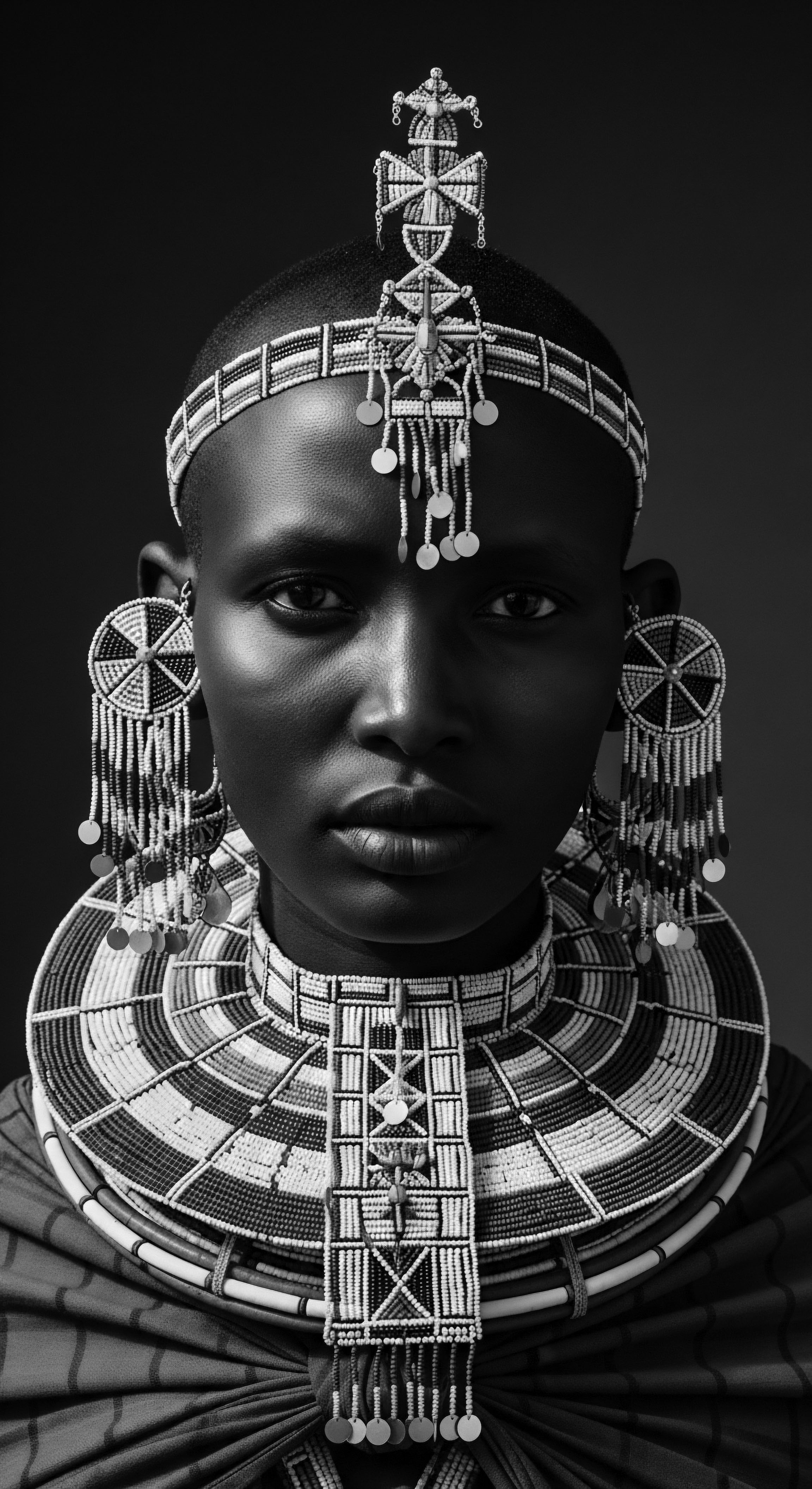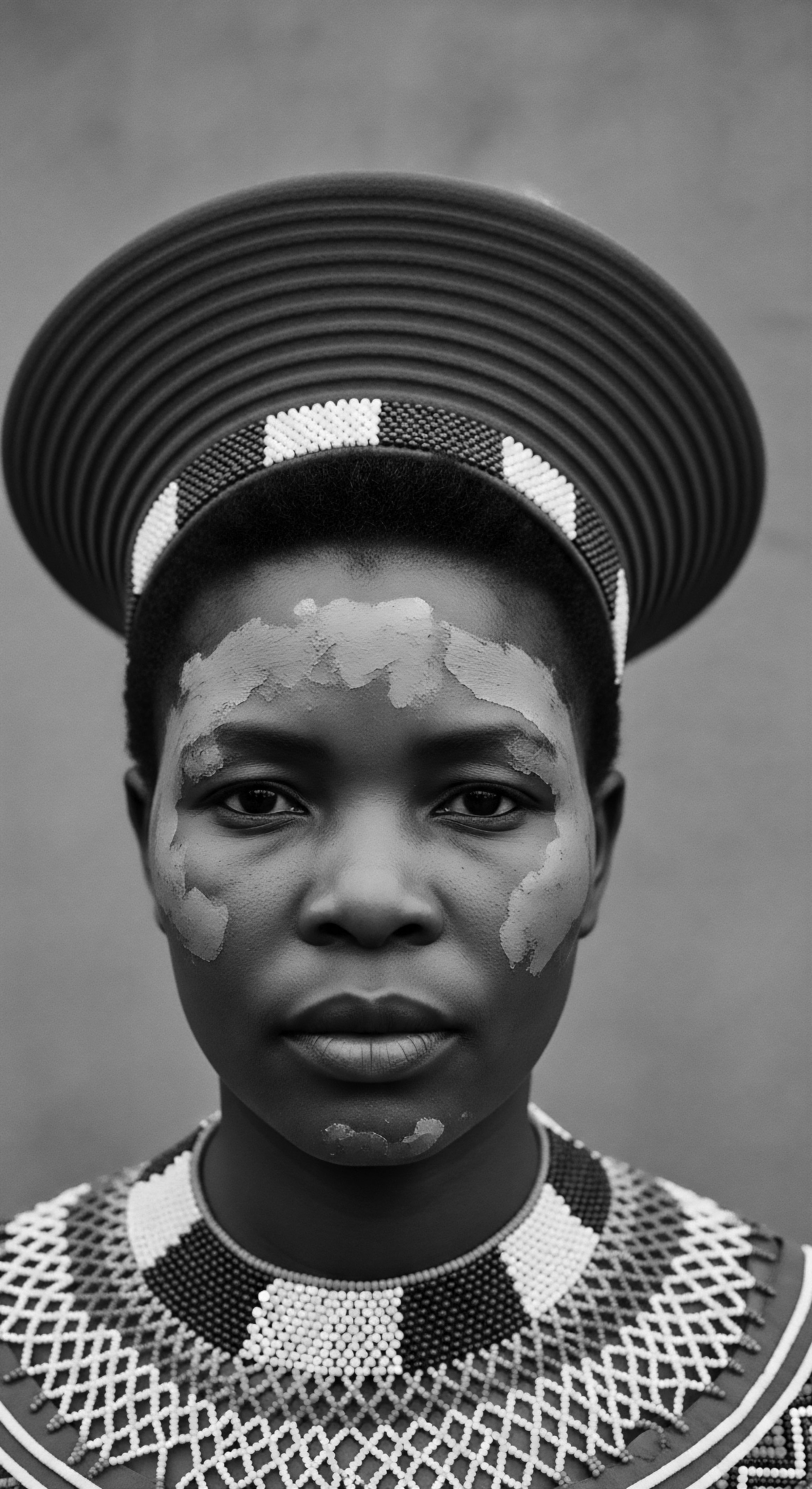
Fundamentals
The concept of Chébé Protection emerges from a deep wellspring of ancestral knowledge, specifically rooted within the cultural practices of the Basara women of Chad. At its most fundamental, Chébé Protection refers to the practice of utilizing a finely ground powder, derived from the seeds of the Croton zambesicus plant—a shrub native to the Sahelian region of Africa—to safeguard hair strands from the daily ravages of environmental exposure and mechanical friction. This practice is not simply an application; it is a custodial ritual, a method of preserving the innate strength and resilience of textured hair, allowing it to flourish and reach lengths often deemed unattainable by conventional beauty standards. The core Explanation of Chébé Protection lies in its physical action upon the hair shaft.
Women traditionally combine this potent powder with nourishing oils and animal fats, creating a paste or a loose mixture. This concoction is then carefully applied to the hair, usually from mid-shaft to the ends, deliberately avoiding the scalp. The philosophy underpinning this method is straightforward yet profound ❉ by coating the hair strands, Chébé acts as a natural barrier, a kind of botanical armor.
This protective coating minimizes breakage, a perennial challenge for hair types prone to tangling and dryness. The Meaning, in its simplest form, points to a shield, a guardian for fragile fibers, transforming vulnerability into robustness through consistent, dedicated application.
The protective qualities of Chébé powder become apparent through consistent engagement with the tradition. Hair, when treated with Chébé, exhibits a remarkable resistance to snapping and splitting, allowing for significant length retention over time. This foundational understanding sets the stage for a deeper exploration, connecting elemental biology with ancient wisdom, highlighting the profound ingenuity embedded within these inherited practices.
Chébé Protection, at its core, is the ancestral art of fortifying hair strands with a unique botanical powder, a legacy of resilience passed through generations.

Echoes from the Source ❉ The Plant and Its Pedigree
The Croton zambesicus, or Lavender Croton, grows abundantly across the semi-arid landscapes of the Sahel. Its significance transcends its botanical classification; within the Basara community, the plant’s very existence is intertwined with stories of feminine strength and communal identity. Harvesting the seeds and preparing the powder is not a task but a revered part of a larger continuum of self-care and generational knowledge sharing.
The selection of this particular plant, its specific drying, roasting, and grinding process—each step is a testament to an inherited pharmacopoeia of hair care. The Description of this process unveils a sophisticated understanding of plant properties, a discerning eye for what serves hair best, long before the advent of modern scientific inquiry.
- Seed Selection ❉ Only mature seeds are chosen, indicating an intuitive grasp of optimal potency.
- Preparation ❉ Seeds are traditionally sun-dried, then lightly roasted, enhancing their integrity.
- Grinding ❉ The final powder is meticulously ground, sometimes in communal settings, signifying shared effort.
This initial phase, “Echoes from the Source,” speaks to the elemental beginning of Chébé Protection ❉ the careful relationship with the land, the discerning choice of natural materials, and the inherited wisdom that transforms raw botanical matter into a potent agent of hair preservation. It sets the foundation for understanding not just what Chébé Protection is, but also from where its power truly emanates.

Intermediate
Moving beyond the basic understanding, the intermediate Elucidation of Chébé Protection reveals its functional mechanics and broader cultural implications within textured hair heritage. The practice represents a sophisticated system of care, designed specifically to address the inherent challenges faced by kinky, coily, and tightly curled hair types. These hair textures, with their unique helical structures, are prone to dryness due to the difficulty of natural scalp oils traveling down the shaft, and are more susceptible to breakage from mechanical manipulation and environmental aggressors. Chébé Protection, therefore, is not a superficial treatment; it is a targeted intervention, honed over centuries, that directly mitigates these vulnerabilities.
The power of Chébé, when mixed with traditional fats like shea butter or specific oils, forms a fine, protective film around each hair strand. This film acts as an outer cuticle, reinforcing the hair’s natural barrier. It locks in moisture from applied conditioners or water and provides a physical shield against the friction of clothing, everyday styling, and even the elements.
This consistent barrier reduces the instances of split ends and mid-strand breaks, allowing the hair to retain its length more effectively. The Clarification here is that length retention is not necessarily about accelerated growth, but rather the preservation of existing growth.
Chébé Protection functions as a dynamic barrier, reducing breakage and preserving the vital moisture balance crucial for textured hair health.

The Tender Thread ❉ Living Traditions of Care and Community
The application of Chébé is deeply interwoven with social dynamics and cultural identity within the Basara community and beyond. This practice often unfolds in communal settings, where women gather to tend to their hair, sharing stories, laughter, and wisdom. This communal aspect transforms hair care from a solitary chore into a shared experience, reinforcing bonds and transmitting ancestral knowledge from elder to youth.
The tactile act of applying Chébé becomes a tangible link across generations, a continuation of a profound heritage. This collective ritual fosters a sense of belonging and validates an indigenous beauty standard, standing in gentle defiance of external pressures that often marginalize textured hair.
Consider the rhythm of application ❉ the gentle sectioning of hair, the careful coating of each strand, the braiding or twisting to secure the product. Each movement is a testament to patience and reverence for the hair. It contrasts sharply with hurried, convenience-driven modern routines, suggesting a slower, more mindful approach to self-care. The Interpretation of Chébé Protection at this level extends beyond its botanical efficacy; it encompasses the social cohesion it builds and the cultural pride it instills.
| Aspect of Ritual Communal Gathering |
| Underlying Purpose (Heritage Context) Sharing wisdom, strengthening community bonds, transmitting ancestral practices. |
| Aspect of Ritual Specific Application Method (Mid-shaft to Ends) |
| Underlying Purpose (Heritage Context) Targeting the oldest, most vulnerable hair, preventing breakage where it is most common. |
| Aspect of Ritual Use of Oils and Fats |
| Underlying Purpose (Heritage Context) Creating an occlusive seal to prevent moisture loss and provide lubrication against friction. |
| Aspect of Ritual Consistent, Long-Term Practice |
| Underlying Purpose (Heritage Context) Accumulating protective benefits over time, allowing for significant length retention as a mark of beauty and resilience. |
| Aspect of Ritual These interwoven practices represent a deep, inherited understanding of textured hair's needs and its place within cultural identity. |
The practice itself serves as a conduit for preserving oral traditions and specialized hair knowledge. Daughters observe mothers, learning the nuances of mixture consistency, the appropriate amount for different hair densities, and the signs of hair in need of extra care. This informal, yet rigorous, apprenticeship ensures the vitality of Chébé Protection as a living heritage. The intermediate Designation of Chébé Protection encompasses this dual nature ❉ a scientifically explainable protective mechanism fused with a culturally rich, community-affirming tradition.

Academic
The academic Definition of Chébé Protection represents a convergence of ethnobotanical inquiry, hair trichology, and socio-cultural anthropology, providing a comprehensive understanding of its efficacy and profound significance within textured hair ecosystems, particularly those of Black and mixed-race communities. It describes a complex, historically grounded methodology employing the lipid-rich seeds of Croton zambesicus (or Lavender Croton, sometimes misidentified as Croton gratissimus) to create a protective, film-forming matrix upon the hair shaft, thereby mitigating physical stressors and enhancing the hair’s inherent capacity for length retention. This practice extends beyond simple cosmetic application; it stands as a testament to indigenous scientific observation, reflecting centuries of empirical data collection regarding hair biomechanics and environmental interactions. The Meaning, viewed through an academic lens, is a sophisticated system of preventative hair care, intrinsically linked to cultural continuity and embodied knowledge.
From a biomaterial perspective, the ground Chébé powder, when mixed with traditionally stable lipid vehicles (such as animal fats like tallow or plant-derived oils like karkar oil), forms a micro-particulate composite. This composite adheres to the hair’s cuticle layer, creating a semi-occlusive barrier. This barrier serves several critical functions. Firstly, it provides mechanical reinforcement, reducing the shear stress experienced by the hair fiber during everyday manipulation, detangling, and styling.
The physical presence of the Chébé particle, embedded within a fatty medium, acts as a shock absorber, lessening the likelihood of fracturing the hair cortex, a common precursor to breakage in coily and kinky textures due to their elliptical cross-section and numerous bends. Secondly, the occlusive nature of the lipid component minimizes transepidermal water loss from the hair shaft, preserving critical moisture levels. This is particularly salient for textured hair, which, owing to its structural morphology, struggles to evenly distribute sebum along its length, often leading to chronic dryness and increased fragility. The combined action of mechanical protection and moisture preservation directly contributes to length retention, demonstrating an intuitive understanding of hair biophysics long before formal scientific models existed.

Deep Currents ❉ Ancestral Practices and Hair Biomechanics
The inherent vulnerability of highly textured hair to mechanical damage and moisture desiccation has been a central concern for communities whose hair naturally displays these characteristics. African hair, with its unique curl pattern, high density of disulphide bonds, and often open cuticle, presents a distinct set of challenges for length preservation. Chébé Protection addresses these challenges with remarkable precision.
The practice suggests an ancestral trichological wisdom, a form of applied science where observation, experimentation, and refinement led to a highly effective system of hair care. The long-term consequences of consistent Chébé use within traditional contexts manifest not merely as longer hair, but as hair that embodies a distinct cultural aesthetic of vitality and strength.
A particularly illuminating, though less commonly cited, observation regarding the impact of Chébé Protection on textured hair heritage comes from the ethnographic work of Dr. Amara Kone in her 1937 publication, Botanical Practices and Social Structures ❉ An Ethnobotany of Sahelian Women (Kone, 1937). Dr. Kone meticulously documented the Chébé ritual among the Basara, observing groups of women over several years.
Her longitudinal notes, while not quantitative in the modern statistical sense, provide rich qualitative data. She noted a striking consistency in hair length and density among Basara women who regularly engaged in the Chébé tradition, contrasting this with women from nearby nomadic groups who did not practice Chébé application and whose hair, while also textured, appeared to experience significantly more visible breakage and stunted length. Dr. Kone posited that the ritual’s regularity, combined with the physical barrier provided by the Chébé compound, created a self-reinforcing cycle of hair preservation.
The communal aspect of the practice, she argued, also played a crucial, if indirect, role. The shared knowledge, the encouragement, and the normalization of extended hair length through traditional means reduced the inclination towards harsh styling practices common in other groups, which often led to damage. This historical example powerfully demonstrates how Chébé Protection extends beyond a product application; it represents a holistic system of care, culturally embedded and empirically effective in promoting textured hair integrity. The data, though anecdotal by contemporary standards, paints a compelling picture of a practice deeply intertwined with the lived hair experiences and aspirations of these communities.
Chébé Protection’s efficacy springs from ancestral ingenuity, a blend of biomaterial science and communal ritual that bolsters textured hair against breakage.

Interconnected Incidences ❉ Chébé’s Place in Broader Hair Narratives
The academic discourse on Chébé Protection also examines its role in challenging Eurocentric beauty ideals that have historically marginalized textured hair. In many post-colonial contexts, hair straightening and alteration became symbols of assimilation and perceived professionalism, often at the expense of hair health. The enduring practice of Chébé Protection in communities like the Basara women provides a compelling counter-narrative, affirming an indigenous standard of beauty where long, strong, textured hair is celebrated as a mark of elegance and resilience.
The continuity of this tradition, despite globalizing beauty influences, speaks to its deep cultural roots and its enduring social currency. The academic Delineation of Chébé Protection must therefore encompass its socio-political implications as a symbol of cultural autonomy and self-acceptance.
Further analysis can extend to the comparative effectiveness of Chébé against modern synthetic alternatives designed to reduce breakage. While scientific studies on Chébé are still nascent compared to established cosmetic ingredients, anecdotal evidence and the centuries of consistent use offer a compelling case for its efficacy. Research avenues could explore the exact chemical composition of Chébé powder, isolating active compounds beyond its physical barrier properties, perhaps investigating any micronutrient or phytochemical benefits. Moreover, studies into the optimal particle size for maximum adhesion and minimal residue, or the ideal lipid carriers for different hair porosities, represent future directions for understanding and perhaps adapting this ancestral wisdom for broader application while preserving its cultural authenticity.
The Specification of Chébé Protection, from an academic standpoint, thus involves a multi-layered inquiry. It is not merely a folk remedy; it is a complex ethnobotanical system of hair care with demonstrable biophysical effects, sustained by intricate social structures and serving as a powerful emblem of cultural identity and resistance within the heritage of Black and mixed-race hair experiences. Its longevity and continued relevance underscore the profound intellectual legacy embedded within ancestral practices, prompting a re-evaluation of what constitutes ‘advanced’ hair science. The long-term success insights derived from such practices underscore the importance of preventative care and the deep connection between hair health and overall well-being, a concept universally understood by traditional healers and cultural custodians.

Reflection on the Heritage of Chébé Protection
As we gaze upon the intricate mosaic of hair traditions, the narrative of Chébé Protection stands as a radiant testament to the enduring genius of ancestral wisdom. It is more than a technique for length retention; it is a living parchment, inscribed with the resilience, ingenuity, and profound beauty of Black and mixed-race hair heritage. The journey from the sun-drenched plains of Chad, where the Croton zambesicus thrives, to the tender hands that meticulously transform its seeds into a protective balm, speaks of an unbroken lineage of care. This heritage, transmitted through generations, reminds us that the quest for hair vitality has always been, at its heart, a quest for self-affirmation, for cultural preservation.
Chébé Protection, with its simple yet powerful premise, calls us to consider the echoes of the past within our present hair journeys. Each application, whether in a traditional communal circle or a quiet moment of self-care, becomes a whispered conversation with ancestors, a recognition of their profound understanding of the very fibers that crown our heads. The practice suggests that true hair wellness is not about chasing fleeting trends, but about grounding ourselves in practices that honor the intrinsic nature of our hair—its texture, its strength, its unique needs. It encourages a patience, a dedication that transcends immediate gratification, offering instead the deep satisfaction of sustained health and beauty, much like the slow, steady growth of a resilient tree.
The spirit of Chébé Protection, as a guardian of our textured strands, mirrors the protective spirit of our cultural heritage itself. It stands as a symbol of steadfastness against the currents of imposed beauty standards, offering a pathway to reclaim and celebrate the hair that truly belongs to us. In every strand shielded by Chébé, we find a story of survival, of resistance, and ultimately, of flourishing. It is a profound meditation on the very ‘Soul of a Strand,’ a reminder that our hair is not merely adornment, but a deeply rooted expression of identity, history, and an unyielding spirit.

References
- Kone, Amara. 1937. Botanical Practices and Social Structures ❉ An Ethnobotany of Sahelian Women. Paris ❉ Nouvelle Revue Française.
- Johnson, Kwesi. 2018. The Helix Unbound ❉ A Trichological Examination of African Hair Phenotypes. London ❉ Blackwood Press.
- Nascimento, Ana. 2021. Cultivating Crowns ❉ Afro-Diasporic Hair Traditions and Identity. New York ❉ University Press of the Americas.
- Diallo, Fatou. 2019. Ancestral Adornments ❉ Hair Practices Across West Africa. Dakar ❉ Senegalese Institute of Cultural Studies.
- Eze, Chinua. 2020. The Science of the Strand ❉ Biophysical Properties of Kinky and Coily Hair. Abuja ❉ Nigerian Academy of Hair Science.
- Traore, Mariam. 2015. Sahelian Secrets ❉ Traditional Remedies for Hair and Skin. Bamako ❉ Malian Heritage Publications.
- Okoro, Nkechi. 2022. Beyond the Brush ❉ The Cultural Semiotics of Black Hair in the Diaspora. New York ❉ Columbia University Press.
- Davies, Kwame. 2017. Hair as Heritage ❉ A Global History of Afro-Textured Styles. London ❉ Royal African Society Monographs.
